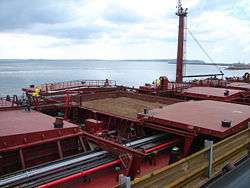Ore-bulk-oil carrier
An ore-bulk-oil carrier, also known as combination carrier or OBO, is a ship designed to be capable of carrying wet or dry cargoes. The idea is to reduce the number of empty (ballast) voyages, in which large ships only carry a cargo one way and return empty for another. These are a feature of the larger bulk trades (e.g. crude oil from the Middle East, iron ore and coal from Australia, South Africa and Brazil).

The Russian word for 'ore-bulk-oil carrier', nefterudovoz (нефтерудовоз, literally 'oil/ore carrier'), in combination with a number, is often used as a proper name for a ship, e.g. Nefterudovoz-51M. [1][2]
History
The idea of the OBO was that it would function as a tanker when the tanker markets were good and a bulk / ore carrier when these markets were good. It would also be able to take "wet" cargo (oil) one way and "dry" cargo (bulk cargoes / ore) the other way, thus reducing the time it had to sail in ballast (i.e. empty).
The first OBO carrier was Naess Norseman, built at A. G. Weser for the company Norness Shipping, controlled by the Norwegian shipowner Erling Dekke Næss. Næss was instrumental in conceiving the new type of vessel, together with his chief naval architect Thoralf Magnus Karlsen. Naess Norseman was delivered in November 1965 and was 250 m (820 ft) long with a beam of 31.6 m (104 ft), a draft of 13.5 m (44 ft), and a gross register tonnage of 37,965 tonnes.
The OBO carrier quickly became popular among shipowners around the world and as of today several hundreds of this type of vessel have been built. The ship type had its glory days in the early 1970s. In the 1980s, it became clear that the type required more maintenance than other vessels. Also, it was expensive to "switch" from wet to dry cargoes, and it took valuable time. If you had carried oil, you could switch to carrying ore or other dirty bulk cargoes, but not grain or other clean bulk cargoes. As the 1970s-built OBO vessels become older, most of them were used either as pure tankers or as pure ore carriers.
In the 1990s, a smaller number of OBOs from 70,000 tonnes deadweight (DWT) to 100,000 t DWT were built for the account of Danish and Norwegian shipowners.
Today
OBO-carriers are today not as common as they were in the 1970-1980s. This is due to investors seeking assets that are easily valued, whilst the value of the OBO is only appreciated by those operating them. With few of them being ordered after the 1980s, most are time-expired and no longer exist. Some ship-owners continued to support the OBO-concept and its trading flexibility. SKS,[3] part of the Kristian Gerhard Jebsen Group, is today operating the largest OBO-fleet in the world consisting of 10 OBO carriers. The latest obo-vessel in the fleet, D Whale, was delivered from Hyundai Heavy Industries.[4] The design of these vessels has been significantly improved compared to the vessels made in the seventies and all problems which were related to the OBO-concept - including many that were common amongst tankers at that time - have been dealt with.
A fleet of smaller, "river-sized" (several thousand tonnes) ore-bulk-oil carriers have also been used for some decades on European Russia's waterways, primarily by Volgotanker.
Accidents
In addition to MV Berge Istra and MV Berge Vanga, one of the more famous OBOs was the Derbyshire MV Derbyshire of 180,000 deadweight tonnes, which in September 1980 became the largest British ship ever lost at sea. It sank in a Pacific typhoon while carrying a cargo of iron ore from Sept-Îles in Canada to Japan. The loss of Derbyshire was found to be due to water ingress in the forward part of the ship subsequent to which IMO rules required higher hatch strengths of the forward hatch(es) to ensure greater resistance to green seas coming over the forecastle (which itself had become less common in ship designs)